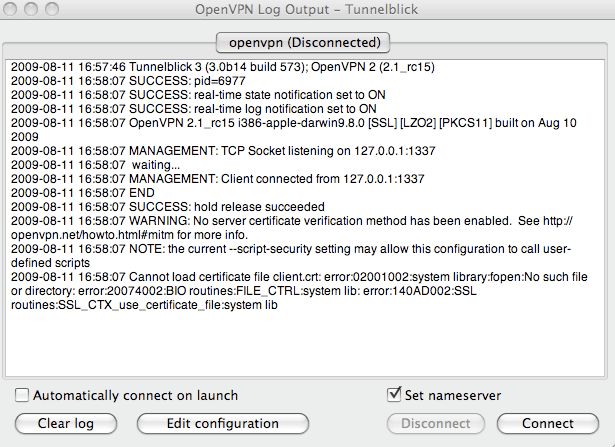

This entry was posted in Howto, Workedforme on Octoby ColinM. You should now be able to ping internal hosts by their internal DNS names, e.g.:.If all goes as planned, you will see your VPN DNS resolver properly included in the configuration. Then connect to your VPN in Tunnelblick, and run the command again: To see the current configuration of DNS resolvers. Time to test! Open a Terminal window, and run the command:.

Tunnelblick will also prompt you again for your administrator password, since security-sensitive files have been modified. Changing your configuration file will have disconnected Tunnelblick if it was connected.Edit your configuration file to include these lines:.Now, make the script executable, by running:Ĭhmod +x ~/Library/openvpn/tap-up-down.sh.OpenVPN TAP up-down Script: tap-up-down.sh Save it to ~/Library/openvpn, the folder where your Tunnelblick OpenVPN configuration lives. Download this script (copied from the openvpn-users mailing list).If not, consult the documentation for OpenVPN.
TUNNELBLICK SET NAMESERVER HOW TO
I’ll assume that you know how to do this, or you wouldn’t be here.

The problem is discussed further on nicholas riley’s blog, though his solution, a python script, a) is complicated to install, and b) did not actually work for me once installed, though I didn’t dig deep enough to understand why. These together can manage 10.4’s new DNS configuration system, and set the tap device to obtain an address via DHCP. The solution? A combination of two tools: ipconfig and scutil. However, this does not work on a Mac, because Mac software (even down to ssh and ping) doesn’t use /etc/nf under OS X 10.4… Oops. Consult your distro’s openvpn documentation for more information. On a linux system, you could, for example, incorporate these into /etc/nf. When you connect via OpenVPN, it is the responsibility of the client to process pushed dhcp-options (including the DNS server rules), and do something useful with them. Write to TUN/TAP : Input/output error (code=5) The Solution Perhaps you even see a large number of errors of the type: You’ve tried connecting, and it just doesn’t seem to work. Your OpenVPN server will be serving DHCP, as well as pushing down DNS server addresses.
TUNNELBLICK SET NAMESERVER MAC OS
You want to run an OpenVPN Client on Mac OS X.


 0 kommentar(er)
0 kommentar(er)
